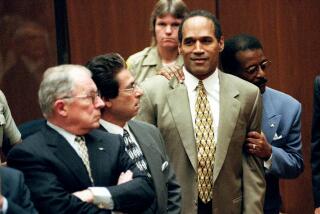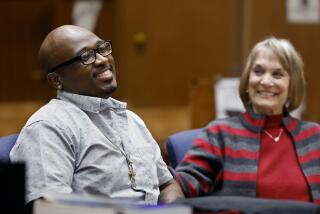‘The First Rule’ by Robert Crais
Since Robert Crais first introduced Elvis Cole and Joe Pike in 1987’s “The Monkey’s Raincoat,” readers have been treated to one of the best, albeit unlikely, partnerships in crime fiction. Yet it’s inherent in such pairings -- whether it’s Holmes and Watson or Spenser and Hawk -- that one character ends up in the shadow of the other. For Crais, that shadow role falls to Pike (few dare call him Joe), an enigmatic, Zen-like warrior who has been the sidekick to the wisecracking Cole for most of the series with the notable exception of 2007’s “The Watchman,” in which Pike had the lead. There, as he began in 1999’s “L.A. Requiem,” Crais revealed tantalizing bits of Pike’s back story and psychological underpinnings, enriching his writing and the series in the process.
Pike has the lead again in “The First Rule,” which takes readers on a multicultural guided tour of Los Angeles crime, from Westwood to Willowbrook, Marina del Rey to Lake View Terrace. The book opens with Frank Meyer, one of Pike’s associates from his days as a “professional military contractor” (a.k.a. mercenary).
Frank’s gotten out of the mercenary business, cutting off his old friends Pike, Jon Stone and others in favor of life as a garment importer, complete with a wife and two sons in Westwood. Just as the reader is settling into this tableau of domestic bliss, Frank, wife Cindy and the boys, one of whom is named after Joe, are murdered in a home-invasion robbery that critically injures their nanny, Ana Markovic. The attack is one of many plaguing West L.A. and the Encino hills, and is notable not only for its graphic viciousness but also for the presence of a fourth participant, a mysterious Eastern European riding along with three African American perpetrators.
Soon enough, LAPD detectives connect Meyer to Pike and come calling on the retired mercenary, gun-shop owner and occasional partner-in-crime-fighting of Cole. The police think the hit on Frank and his family may have been connected to seven other lethal attacks, all on criminals, leading them to posit that Frank “The Tank” may have been importing more than just garments. Refusing to believe it, Pike sets out to clear his friend’s name and exact revenge on the killers, not necessarily in that order.
Crais spends more than a third of “The First Rule” laying the groundwork for the thrills to come -- reuniting Pike with Jon Stone, whose insane grief for Frank demands retribution; seeking out Lonny Tang, an incarcerated murderer whose life Meyer saved, for critical insight; and tapping John Chen, an old contact from the LAPD’s crime lab, for access to the crime scene and important forensic information.
But, most of all, readers discover Pike’s mournful longing for connection, not just with his long-estranged and now dead friend, but for a life like Frank’s -- filled with love, warmth and family photos -- that may be beyond his reach: “Pike’s life had led to blank walls, and now he wondered if his walls would ever be filled.”
As Pike seeks out Ana at UCLA Medical Center’s intensive care unit, he meets her sister Rina, a no-nonsense Serb who appears to be every bit as lethal as Pike and who provides an alternate motive behind the crime -- that a ruthless Serbian crime lord, Michael Darko, had hit the Meyer residence in search of his and Rina’s baby, who was hidden with Ana. That possibility presents new motives for Pike’s quest and a new innocent to protect.
Along the way, Pike uses the skills he developed as a mercenary and longtime badass in searching for the infant. Joining with Cole, still good for a joke or reliable backup, Pike enlists Stone, Rina and her would-be boyfriend Yanni in the quest. Bending the law to the breaking point, Pike also attracts the attention of the LAPD, the Sheriff’s Department and, most notably, Kelly Walsh, an ATF operative. Walsh opens up bigger possibilities in the case, ones that lead Pike and the reader on a deadly chase before several tense, action-filled battles occur that will test Pike’s moral compass, reawaken protective instincts dating to his childhood and severely test readers’ nerves.
To say more would spoil the enjoyment of one of the better entries in the Cole/Pike saga, one that will satisfy longtime fans and make new ones seek out the earlier titles. But for all the well-written action sequences and snappy dialogue -- two skills that former television writer Crais routinely brings to his writing -- it is Pike’s more reflective moments that linger in the mind, especially when he makes a tentative move to fill those empty walls.
Such scenes remind me why it is always interesting to see how long-running crime series and their heroes evolve. Elizabeth George’s Sir Thomas Lynley loses a wife; Colin Dexter’s Chief Inspector Morse dies from complications of his diabetes; Michael Connelly’s Harry Bosch evolves from Vietnam loner to single father. And though Joe Pike’s evolution may not be as dramatic, one hopes it signals Pike’s further emergence from the shadows -- sooner rather than later.
Woods is the author of eight books, including four mysteries featuring LAPD homicide detective Charlotte Justice.
More to Read
Sign up for our Book Club newsletter
Get the latest news, events and more from the Los Angeles Times Book Club, and help us get L.A. reading and talking.
You may occasionally receive promotional content from the Los Angeles Times.






